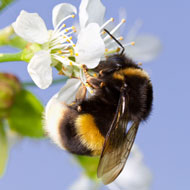Scientists reveal how bees find their way back home

A network of neurons integrates every change in direction and distance on outbound journeys.
New research has revealed how the wiring of bees’ brains helps them to find their way back home.
The study unveils how insects locate their hive after long and complicated journeys. It shows that a network of neurons integrates every change in direction and distance on outbound journeys, enabling bees to plot a direct route home.
Bees use visual perception to navigate, but until now it was not understood what goes on inside their brains. The discovery of these neurons has allowed researchers to show, for the first time, how a bee’s brain guides it home.
The neurons are located in an area of the brain called the central complex. This region plays a vital role in controlling the navigation system, which is used by many animals including bees, ants and humans.
Researchers found that the cells combine every element of an outbound journey, creating a memory that bees use to return to the hive by the most direct route.
The team unravelled the complex working of the bee’s brain by studying nocturnal rainforest bees. They strapped tiny electrodes to the bees’ heads to track brain function as they were exposed to a virtual reality simulation of what they see when flying.
The results helped to create a detailed computer model of the bee’s brain, which was tested on a simulated bee and on a robot. Researchers hope the discovery will steer the creation of new algorithms for navigation in autonomous robots that do not need GPS or expensive computer systems.
“The most exciting part of this research was when computer modelling of the ‘spaghetti’ of connections between nerve cells revealed the elegant principle by which bees keep track of their position and steer back home,” explained professor Barbara Webb, of the University of Edinburgh’s school of informatics, who was involved in the study.
“Understanding such a complex behaviour at the level of single neutrons is an important step forward for the science of brain function”.
Published in the journal Current Biology, the study was carried out in collaboration with the University of Lund, Sweden.



 The RCVS has announced a new version of its 1CPD mobile app, with enhanced features for veterinary surgeons and veterinary nurses to record their continuing professional development.
The RCVS has announced a new version of its 1CPD mobile app, with enhanced features for veterinary surgeons and veterinary nurses to record their continuing professional development.